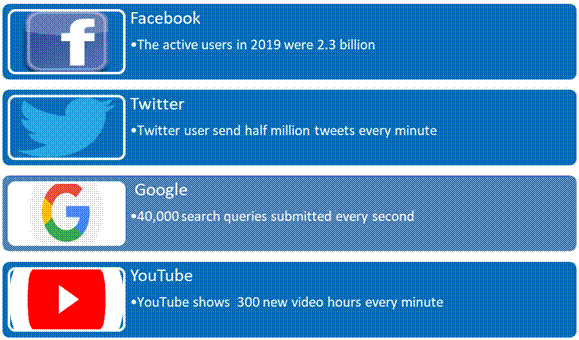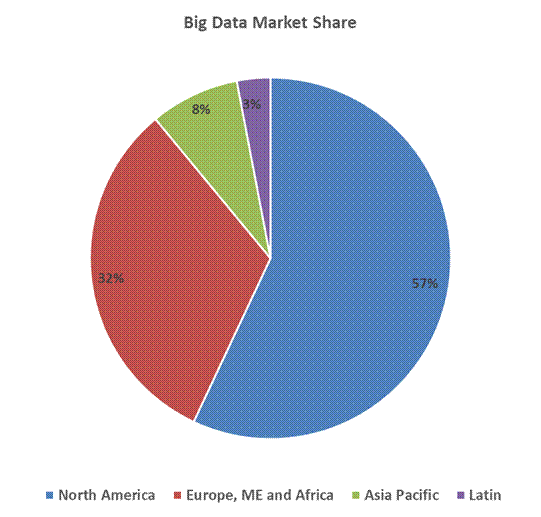Big Data Statistics, Growth & Facts 2024

Big data refers to the massive volume of information that is difficult to be processed using traditional database techniques. It can be either structured or unstructured, and both kinds have innumerable benefits. Big data holds tremendous potential for improving our lives. It can create connections, recognize patterns, and finds use in many innovations like self-driven cars or customizing, developing, improving medical treatments, and accurate weather predictions.
People are becoming more digitized and using more data and information in analyzing even their daily activities. If earlier a person would be just going for a swim, now he knows exactly how many calories he would be burning and other statistics such as heart rate, pulse rate, time, distance, etc. With the given readings, the user can compare this to the previous performance as well. All these and more are possible with vital information, and the big data scene seems to be growing at a fast rate and penetrating diverse sectors and industries with each passing day. Big data keeps getting bigger.
Key Stats:
- The big data market reaching an estimated value of $103 billion by 2023
- It’s estimated 97.2% of companies are starting to invest in big data technology
- Every day, internet users create 2.5 quintillion bytes of data
- IDC’s Digital Universe Study from 2012 found that just 0.5% of data was actually being analyzed.
- It is estimated that by 2021 every person will generate about 1.7 megabytes of data per second.
- Companies like Netflix leverages Big Data to save US$1 billion per year on customer retention

The growth of big data seems unstoppable. The magnitude of data available online merely is vast, with large data getting added every second. Every day 2.5 quintillion bytes of data are generated online. An interesting finding by Physics.org says that to download the total available data online, you would require around 181 million years.
Why is Big data growing?


The growth of data is not surprising because the time internet users spent online came to 2.8 million years in 2018 alone. Search engines, e-commerce, and social media have significantly contributed to this high volume of internet penetration in the global population.
- 33% of the time users spent online is on social media. Global Web Index study shows that the social media users had on an average three social accounts in 2012, and by 2016 the average accounts per user rose to 7.
- The time users spent on social media sites have also increased. The average time social media took was 1 hour 30 minutes in 2012, which increased to 2 hours and15 minutes in 2017.
The breakup statistics of online engagement by users show that 33% of the time people spent on social media. Online TV streaming takes 16%, and movie streaming takes another 16%. Browsing for news on the online press takes 13%, and all other activities take 22%.
- The active Facebook users in 2019 were 2.3 billion. It is indeed a considerable number, and you can imagine the data potential they would have carried. In 2012 the Facebook users were found to share every tiny 684,478 pieces of content. In 2014 this number reached 2.46 million, which is a four-time increase. Statistics published by Domo in 2015 states that Facebook users in 1 minute like 4.1 million posts.
- Twitter users send every minute half-million tweets. A study by Domo found that the number of tweets in a minute was 456,000 in 2017, and it increased to 473,400 in 2018. Internet Live stats of 2019 show that in 1.5 months, the tweets by Twitter users were 30 billion.
- Google records a yearly search volume of 1.2 trillion, with 40,000 search queries submitted every second.
- YouTube shows videos of 300 new hours each minute, and the data YouTube has on its servers exceeds 1 billion gigabytes.
- Smartphones contribute 80% of photos, which can add to the shipping of 1.4 billion devices globally.
- Smart devices like fitness trackers and sensors generate daily 5 quintillion bytes data. These gadgets are expected to cross 50 billion numbers in five years.
- Cloud computing is also catching up and increasing data generation. Cloud computing can improve business performance by 29% and reduce payback times by 30%.
- Google and other such big companies are using shared data for better customer satisfaction, and for answering each query, around 1000 computers get involved.
- The compound annual growth rate of Hadoop is 58%, and it is expected to cross $1 billion by 2020.
With internet usage and data consumption increasing day by day, Big data can be seen to continue growing without boundaries.
Big data and its value
Economists compared data to oil in 2017, stating that data replaces oil as the most valuable source in the world. When you compare oil and data, interesting observations come to the forefront of the utility segment, which is unlike that of oil data. It is easily extractable with endless sources and potential for multiple uses. However, not all data available online creates value. The utility of data comes only when it is tagged and analyzed to produce meaningful information. According to IDC’s 2012 study, only 0.5% of data has analyzed, and 3% has tagged to date. The data which can be analyzed was only 22% in 2010 and is expected to reach 37% in 2020.
Interesting facts on big data

Here are a few facts on big data to illustrate its growth in recent times and the ripple it is creating in the world.
- By 2023, the big data analytics market is expected to reach $103 billion. The big data market is projected to grow by 20%.
- In one second, each person is expected to generate 1.7 megabytes of data by 2020.
- A study by IDC shows that the data by 2020 is expected to reach 40 trillion gigabytes. The size of big data in 2010 was 1.2 zettabytes. The study also claimed that the till 2020 digital universe will be doubling every 2 years.
- A study by IBM in 2017 showed that 90% of data have created during the last 2 years. The sudden spurge of data can attribute to the stupendous growth of the internet. The internet users that was only 2.5 billion in 2012 reached 3 billion in 2014 and touched 4.1 billion in 2019.
- Netflix saves $1 billion every year by channelizing Big data for customer retention. It is possible by using Big data for improving user experience through personalized recommendations.
- By 2020, Big data is expected to grow further thanks to technological advancements like automated processes (Hadoop, Spark), smart wearables, machine learning, and so on.
- A study by Flat World Solutions estimates that if the businesses utilize a data-driven approach, they will gain $430 billion by 2020.
- In 2019, the most significant contribution to BDA revenue came from IT services, recording a profit of $77.5 billion. Hardware purchases came second with $23.7 billion, and business services contributed $20.7 billion.
- 79% of executives consider that not implementing big data is equal to embracing bankruptcy.
- 83% of organizations are investing in big data projects.
- By increasing the accessibly of data with just 10%, Fortune 1,000 companies will have a gain of $65 million in their net income.
- Healthcare is another sector that can benefit immensely from big data by saving around $300 billion every year.
- By utilizing the full power of big data, companies can make a 60% increase in their operations margin.

The geographical analysis of Big data
Global statistics reveal that big data is continually growing. The generated revenue continues to grow with a profit of $122 billion in 2015. It is expected to grow to $274.3 billion in 2022. Let’s understand the growth of big data in the major countries of the world.
- The US is the largest market of big data, followed by Japan. The BDA revenue in 2019 is estimated to touch $100 billion.
- The UK has generated $9.2 billion in 2019, and it comes as the 3rd largest BDA market. The 2020 projections estimate big data and IoT to touch $420 billion for the UK.
- 57% of the BDA market share belongs to North America. Europe, Middle East, and Africa altogether have 32% of the share. The Asia Pacific and Latin America contribute 8% and 3%, respectively.
- Argentina has the fastest adoption rate of big data at 20.8%. Next comes Vietnam with 19.8%, the Philippines with 19.5%, and Indonesia with 19.4%.
How much is Big data growing

Big data is growing every year due to increasing internet penetration and data consumption by people. It is fascinating to note that by 2020, every human being will create 1.7 megabytes of data each second.
- The global BDA revenue in 2018 was $42 billion, and it is estimated to grow to $103 billion in 2027, recording a CAGR of 10.5%.
- The growing market of Hadoop is projected to show a CAGR of 53.7% between 2015 and 2022.
- China has a CAGR of 31.72% and is the fastest-growing big data market worldwide. The big data revenue of China was $1.2 billion in 2014 and is projected to reach $9 billion in 2020.
- Big data adoption supported by statistics is instrumental in improving retail sales by 3% to 4%.
- The big data software market is also showing an accelerate growth to keep up with the increasing demand. The market is estimated to have grown at a CAGR of 12.6% and to touch a value of $46 billion in 2027.
Industry-wise analysis of big data usage
Big data finds application in all the industries because of the increasing data usage by people and the potential to incorporate big data for streamlining performance and improving user experience. Here a few industries that benefit significantly from using big data are enumerated.
- Healthcare – Study by McKinsey shows that implementing big data can result in a 17% saving of healthcare costs. It helped a cost reduction of $493 billion in 2013.
- Banking – The customers of the banking sector require highly personalized experience, and big data can help a lot in achieving this. Implementing big data in the banking sector can lead to a revenue increase of 18%. It’s incredible to know how American Express has harnessed BDA and developed the ability to predict around 24% of the accounts, which might get closed in 4 months.
- Media – Several media giants have successfully leveraged big data to their advantage. The gaming website, Miniclip, uses big data to decide the games that would be successful and thereby improve customer experience. Miniclip migrated to Amazon Web Services, which specializes in processing big data. As a result, deploying a new game takes only 4 hours now compared to 4 to 5 weeks it used to take earlier. The process has also helped Miniclip to save $1,00,000 on new load balancers. Miniclip has also been able to cut its latency to half and also reduced the time to market by 97%. Netflix is another media corporation which has leveraged big data and save $1 billion yearly in customer retention.
- Retail – Big data has effected remarkable growth in Amazon’s revenue. After introducing AWS, Amazon reported $3 billion earnings in 2017 and $10.1 billion in 2018. Starbucks has benefited in using statistics on big data, and it is presently leveraging big data for smart information gathering. It has 17 million mobile app users and 13 million in reward programs.
- Energy – Big data has been successfully put to use by energy giant General Electric by gathering information on turbines and engines by the sensors installed on it. Big data helped to increase the efficiency of General Electric, and the company expects it can boost productivity in the US by 1.5% Year over Year.
- Medicine – Data collected by using wearable trackers can provide valuable information from patients rather than engaging in personal visits, which is an advantage for doctors and other medical professionals. Big data is helpful for hospitals to develop statistics on the effectiveness of treatments and drug administrations. Big data can help to improve efficiency by 50% and can reduce the duration of admittance by 40%.
- Construction – Big data helps construction companies to quote prices more efficiently and precisely. The data available will help to analyze expenses on human resources and material. When construction companies started to implement the BDA interface, 98% of the sales executives reported a considerable improvement in estimating various aspects of the project completion parameters.
Big Data Investors:
Banking, manufacturing, the Federal Government, and professional services are the industries that have invested heavily in big data. The total investment of these industries in big data will be $129 billion in 2022.
- The combined worldwide BDA share of 4 segments in 2018 was $81 billion, which is 50% of the worldwide BDA.
- By 2022, the four segments’ total investment will be $129 billion.
The following 3 segments will show the fastest revenue growth in the future.
- Banking – 13.2% CAGR
- Retail – 13.5% CAGR
- Professional services – 12.9% CAGR
Advantages of Big Data and its Analytics:
Big Data is beneficial for companies to do wonders. It can help to reduce the cost of operation, increase productivity, helps to develop a new product, create a better atmosphere for decision making, and helps to plug fraud.
Cost reduction:
- Big data software can offer significant contributions to enhance customer service and delivery processes. It will help to increase overall effectiveness, and as a result, companies can enjoy cost reduction.
- Many survey reports are available to support these claims. As per the recent surveys by NewVantage and Syncsort, BDA helped to reduce expenses by 59.4%.
- As many as 66.7% of companies confirmed that they use it for meeting operation cost reductions.
- 55% of participants of the survey aims for increased sales and revenue by using BDA.
Enhanced Productivity:
- BDA tools come with high-speed operation features allowing companies to make quick decisions.
- As per the study by Syncsort, 59.9% of companies use highly dependable software like Hadoop to enhance production.
- As per BDA statistics, it helps to increase the overall effectiveness of operations and personal productivity.
Innovative Product Development:
- Meeting the market trends and developing innovative products is the primary advantage of using BDA.
- About 11.6% of company executives utilize big data as a tool to find ways for innovation.
- A better understanding of BDA helps companies to fair better than their competitors.
Sound Decision Making:
- BDA can use to understand the continuously changing market conditions. It helps companies to understand the purchase habit of customers and strategize production plans and product innovations accordingly.
- During research conducted by NewVantage, 36.2% of companies confirmed the effectiveness of BDA in making decisions.
- 59% of companies reported that they made a huge success in decision making by utilizing the BDA.
Detect cheating and unscrupulous actions:
- BDA plays a significant role in the financial industry, especially in possible default or fraud detection.
- BDA provides vital inputs to understand the pattern of fraudulent actions by developing algorithms based on machine learning. It will allow financial institutions to act fast and prevent possible fraudulent activities before it could happen.
Conclusion:
All these statistics of big data points to the inevitable conclusion that big data is here to stay. Companies are recognizing this and embracing big data in their strategies to gain a competitive advantage, improve customer experience, increase customer retention, and revenue. About 43% of organizations are making substantial changes in their structure to utilize the benefit of big data. With further growth expected in the sphere of big data, it is always required to be updated on the recent developments happening in the field. Using big data, companies can gain the advantage of predicting many events backed by robust data, and that will help to outshine competitors.
Reference links:
More To Explore
Wearable Statistics And Facts For 2021
Industry report Overview of Wearable Statistics And Facts For 20211
Facebook live Statistics, Usage And Facts (2020 Report)
Industry report Overview of Facebook live Statistics, Usage And Facts
Web Hosting Statistics, Market share And Facts For 2021
Industry report Overview of Web Hosting Statistics, Market share And
Explore Related reccomendations
IoT Statistics And Facts For 2020
- According to 0 users
Dropbox Statistics, Users, Growth And Facts For 2021
- According to 0 users
Gmail Statistics, Users, Growth And Facts For 2021
- According to 0 users
The Ultimate List of WordPress Statistics (2020 Data, Studies, Facts)
- According to 0 users


